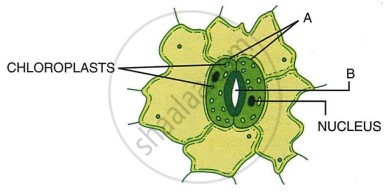Advertisements
Advertisements
प्रश्न
Given below is the diagram of an experimental set up to study the process of transpiration in plants. Study the same and then answer the questions that follow:

(i) What is the colour of dry cobalt chloride paper?
(ii) Is the experimental leaf a monocot or a dicot? Give a reason to support your answer.
(iii) Why axe glass slides placed over the dry cobalt chloride papers?
(iv) After about half an hour what change, if any, would you expect to find in the cobalt chloride paper placed on the dorsal and ventral sides of the leaf? Give a reason to support your answer.
(v) Define the term ‘transpiration’.
उत्तर
(i) The colour of dry cobalt chloride paper is blue.
(ii) Dicot leaf. It has reticulate venation.
(iii) To prevent water vapour of the air from interfering the experiment. .
(iv) The cobalt chloride paper placed on the lower surface of the leaf will show more pink dots as there are more stomata. The upper surface has less stomata than the lower surface.
(v) Loss of water as water vapour from the aerial parts of the plant.
APPEARS IN
संबंधित प्रश्न
Choose the correct answer:
Stomata open during day time because guard cells
Given ahead is the diagram of an experimental set up to study the process of transpiration in plants. Study the same and then answer the questions that follow:

Is the experimental leaf a monocot or a dicot? Give a reason to support your answer.
The figure below represents the vertical section of a leaf:

(i) Name the parts labeled 1 to 5.
(ii) What do the two arrows (dotted and solid) indicate in the day time and at night?
(iii) Could you add one more arrow in the figure? If yes, what for?
(iv) How many leaf veins have been shown in this section?
Given below is an experimental set up to study a particular process:

(i) Name the process being studied.
(ii) Explain the process named in (i) above.
(iii) Why is the pot covered with a plastic sheet?
(iv) Mention one way in which this process is beneficial to the plant.
(v) Suggest a suitable control for this experiment.
Given below is an apparatus used to study a particular process in plants. Study the same and answer the questions that follow :

(i) Name the apparatus.
(ii) Mention one limitation of this apparatus.
(iii) Which phenomenon is studied with the help of this apparatus?
(iv) What is the function of the part marked ‘reservoir’?
(v) What is the role of the air bubble in the experiment?
State the Location:
Stomata
Name the following:
The openings on the barks of trees through which transpiration occurs.
Name the three kinds of transpiration.
Given below is the figure of a stoma. Study the same and answer the following questions:

- Label the guidelines A and B.
- Write the exact location of the above-mentioned structures.
- Mention one important role of structure A.
- Write three important roles for structure B.
- Redraw the same figure when structures A are in flaccid condition. When does the flaccid condition occur?
